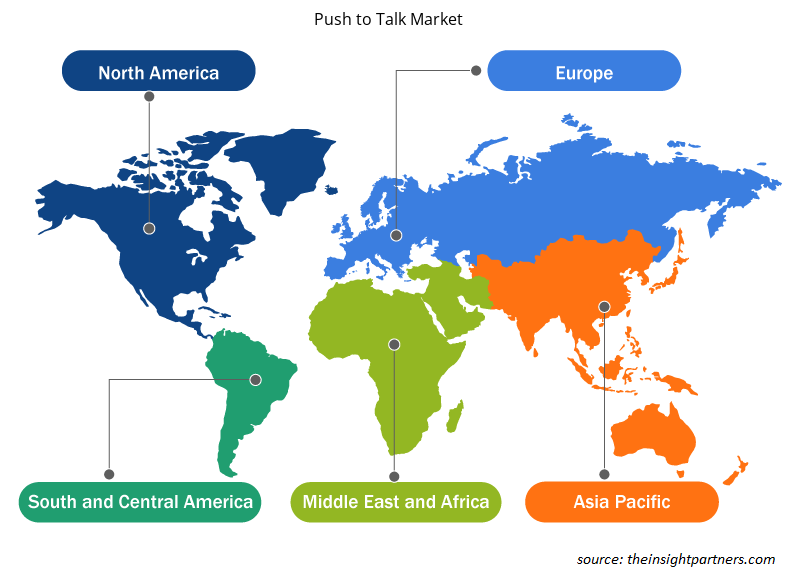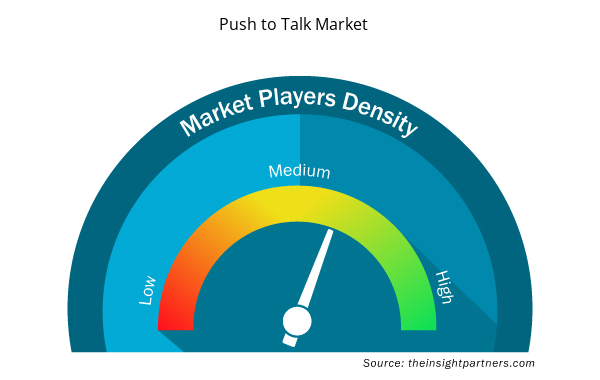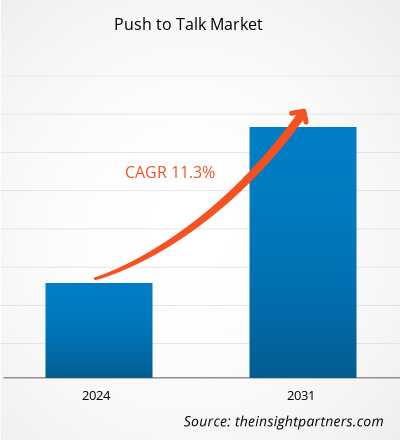Der Push-to-Talk-Markt soll von 34,52 Milliarden US-Dollar im Jahr 2023 auf 81,53 Milliarden US-Dollar im Jahr 2031 anwachsen. Der Markt soll zwischen 2023 und 2031 eine durchschnittliche jährliche Wachstumsrate (CAGR) von 11,3 % verzeichnen. Die wachsende Nachfrage nach Netzwerkgeräten, drahtlosen Geräten und Software dürfte weiterhin ein wichtiger Push-to-Talk-Markttrend bleiben.
Push-to-Talk-Marktanalyse
Der Push-to-Talk-Markt wächst rasant aufgrund der zunehmenden Verbreitung robuster und ultrarobuster Smartphones und der zunehmenden Verbreitung hybrider Kommunikationslösungen. Der Markt wächst stetig, angetrieben durch die steigenden Investitionen des öffentlichen Sektors in die Installation digitaler Landmobilfunksysteme (LMR). Darüber hinaus bieten die Entwicklung von Push-to-Talk-Lösungen auf Basis des Long-Term Evolution (LTE)-Netzwerks und die Weiterentwicklung der 5G-Technologie lukrative Möglichkeiten für Marktwachstum.
Push-to-Talk-Marktübersicht
Push-to-Talk (PTT) ermöglicht Benutzern die sofortige Kommunikation mit schnurlosen Mobiltelefonen, indem von Sprachübertragung auf Sprachempfang umgeschaltet wird. Diese Art der Telefonnutzung ähnelt der Nutzung eines Walkie-Talkies. Push-to-Talk ermöglicht es einer Person, gleichzeitig zu sprechen, während das Telefon vom Vollduplex-Modus, in dem beide Parteien einander gleichzeitig hören können, in den Halbduplex-Modus umgeschaltet wird. An der Unterhaltung können mehrere Personen teilnehmen. Benutzer verwenden Push-to-Talk-Anwendungen auf ihren Mobiltelefonen, die als Walkie-Talkies dienen . Diese Apps erfordern keine zusätzlichen Rechte oder Lizenzen und Verbraucher können sie wie jedes andere Programm auf ihren Smartphones installieren. Benutzer können damit auch mit iOS- oder Android-Telefonen kommunizieren. Eine Vielzahl neuer Trends treiben die Entwicklung der Technologie voran. Wachsende Sicherheitsbedenken, Interoperabilität und nahtlose Integration mit anderen Kommunikationstechnologien treiben den Markt an.
Passen Sie diesen Bericht Ihren Anforderungen an
Sie erhalten kostenlos individuelle Anpassungen an jedem Bericht, einschließlich Teilen dieses Berichts oder einer Analyse auf Länderebene, eines Excel-Datenpakets sowie tolle Angebote und Rabatte für Start-ups und Universitäten.
- Holen Sie sich die wichtigsten Markttrends aus diesem Bericht.Dieses KOSTENLOSE Beispiel umfasst eine Datenanalyse von Markttrends bis hin zu Schätzungen und Prognosen.
Push-to-Talk-Markttreiber und -Chancen
Die zunehmende Verbreitung robuster und ultrarobuster Smartphones treibt den Markt an
Robuste und ultrarobuste Smartphones erfreuen sich bei Verbrauchern auf der ganzen Welt zunehmender Beliebtheit, da die Nachfrage nach robusten, zuverlässigen und widerstandsfähigen Mobilgeräten steigt. Robuste und ultrarobuste Smartphones sind in zahlreichen Branchen stark gefragt, darunter Regierung und Verteidigung, Transport und Logistik, Energie und Versorgung, Bauwesen, Fertigung und andere, um in rauen Umgebungen reibungslos funktionieren zu können. Die zunehmende Integration der Push-to-Talk-Funktionalität in robuste und ultrarobuste Smartphones macht sie zu unverzichtbaren Werkzeugen für Profis und Abenteurer, die unter rauen Bedingungen arbeiten. Diese Faktoren werden den Markt im Prognosezeitraum voraussichtlich ankurbeln.
Entwicklung von Long-Term Evolution (LTE)-basiertenPush-to-Talk-Lösungen – Eine Chance auf dem Push-to-Talk-Markt
Unternehmen nutzen zunehmend fortschrittliche LTE-Netzwerke, um Push-to-Talk-Lösungen zu implementieren, was im Prognosezeitraum voraussichtlich neue Marktchancen schaffen wird. Die Einführung von LTE-Netzwerken in der Mobilkommunikation hat die Land-Mobile-Radio-Kommunikationstechnologie (LMR) ersetzt. Mehrere Organisationen implementieren LTE-Netzwerke , um die Kommunikation zu verbessern. Diese Einführung hat zur Schaffung einer Architektur mit enormer Bandbreite geführt, die unternehmenskritische Push-to-Talk-, Push-to-Locate-, Push-to-Message- und Push-to-Alert-Kommunikationsdienste unterstützen kann. Darüber hinaus integrieren Branchen wie öffentliche Sicherheit, Regierung und Verteidigung, Transport und Logistik und andere LTE-basierte Lösungen in ihre vielfältigen Geschäftsanwendungen, um die Produktivität und Effizienz der Mitarbeiter zu steigern, ihren Arbeitsablauf zu optimieren und die Hardwarekosten des Unternehmens zu minimieren.LTE networks to implement push to talk solutions, which is expected to create opportunities in the market during the forecast period. The introduction of LTE networks in mobile communication has replaced land-mobile radio (LMR) communication technology. Several organizations are implementing networksLTE-powered solutions into their varied business applications to boost workers' productivity and efficiency, optimize their workflow, and minimize corporate hardware costs.
Die zunehmende Implementierung von drahtlosen Technologien wie WLAN und LTE in Push-to-Talk-Geräten verbessert jedoch die effektive Kommunikation in größeren Bereichen. Dies steigert die Nachfrage nach kostengünstigen Push-to-Talk-Lösungen über LTE-Netzwerke.WLAN and LTE in push to talk devices enhances effective communication in larger areas. This is boosting demand for cost-effective LTE network-powered push to talk solutions.
Push-to-Talk-Marktbericht – Segmentierungsanalyse
Wichtige Segmente, die zur Ableitung der Push-to-Talk-Marktanalyse beigetragen haben, sind Komponente, Unternehmensgröße, Netzwerktyp und Endbenutzer.
- Basierend auf den Komponenten ist der Push-to-Talk-Markt in Hardware, Software und Dienste unterteilt. Das Hardwaresegment hatte im Jahr 2023 einen größeren Marktanteil.
- Auf der Grundlage der Unternehmensgröße wird der Markt in Großunternehmen und KMU segmentiert. Das Segment der Großunternehmen hatte im Jahr 2023 einen größeren Marktanteil.
- Basierend auf dem Netzwerktyp ist der Push-to-Talk-Markt in Landmobilfunk und Mobilfunk unterteilt. Das Segment Landmobilfunk hatte im Jahr 2023 einen größeren Marktanteil.
- In Bezug auf die Endnutzer wird der Push-to-Talk-Markt in die Bereiche Regierung und Verteidigung, Transport und Logistik, Reisen und Gastgewerbe, Energie und Versorgung, Bauwesen, Fertigung und andere unterteilt. Das Segment des terrestrischen Mobilfunks hatte 2023 einen größeren Marktanteil.
Push-to-Talk-Marktanteilsanalyse nach geografischer Lage
Der geografische Umfang des Push-to-Talk-Marktberichts ist hauptsächlich in fünf Regionen unterteilt: Nordamerika, Asien-Pazifik, Europa, Naher Osten und Afrika sowie Südamerika/Süd- und Mittelamerika.
In Bezug auf den Umsatz hatte der nordamerikanische Markt den größten Push-to-Talk-Marktanteil, was auf die Präsenz von Telekommunikationsdienstleistern und Proof-of-Concept-Anbietern wie Motorola Solutions und AT&T Intellectual Property sowie die zunehmende Verbreitung zentraler Kommunikationstechnologien zurückzuführen ist. Der steigende Bedarf der Verbraucher an kostengünstigen und effizienten Lösungen treibt den Markt an. Der Markt in den USA dürfte in naher Zukunft aufgrund der zunehmenden Verbreitung von Push-to-Talk-Lösungen in einer Vielzahl von Endverbrauchsbranchen, darunter Regierung und Verteidigung, öffentliche Sicherheit, Gesundheitswesen und andere, wachsen.
Regionale Einblicke zum Push-to-Talk-Markt
Die regionalen Trends und Faktoren, die den Push-to-Talk-Markt im Prognosezeitraum beeinflussen, wurden von den Analysten von Insight Partners ausführlich erläutert. In diesem Abschnitt werden auch Push-to-Talk-Marktsegmente und -Geografie in Nordamerika, Europa, im asiatisch-pazifischen Raum, im Nahen Osten und Afrika sowie in Süd- und Mittelamerika erörtert.

- Holen Sie sich regionale Daten zum Push-to-Talk-Markt
Umfang des Push-to-Talk-Marktberichts
| Berichtsattribut | Details |
|---|---|
| Marktgröße im Jahr 2023 | 34,52 Milliarden US-Dollar |
| Marktgröße bis 2031 | 81,53 Milliarden US-Dollar |
| Globale CAGR (2023 - 2031) | 11,3 % |
| Historische Daten | 2021-2022 |
| Prognosezeitraum | 2024–2031 |
| Abgedeckte Segmente | Nach Komponente
|
| Abgedeckte Regionen und Länder | Nordamerika
|
| Marktführer und wichtige Unternehmensprofile |
|
Dichte der Push-to-Talk-Marktteilnehmer: Die Auswirkungen auf die Geschäftsdynamik verstehen
Der Push-to-Talk-Markt wächst rasant, angetrieben von der steigenden Nachfrage der Endnutzer aufgrund von Faktoren wie sich entwickelnden Verbraucherpräferenzen, technologischen Fortschritten und einem größeren Bewusstsein für die Vorteile des Produkts. Mit steigender Nachfrage erweitern Unternehmen ihr Angebot, entwickeln Innovationen, um die Bedürfnisse der Verbraucher zu erfüllen, und nutzen neue Trends, was das Marktwachstum weiter ankurbelt.
Die Marktteilnehmerdichte bezieht sich auf die Verteilung von Firmen oder Unternehmen, die in einem bestimmten Markt oder einer bestimmten Branche tätig sind. Sie gibt an, wie viele Wettbewerber (Marktteilnehmer) in einem bestimmten Marktraum im Verhältnis zu seiner Größe oder seinem gesamten Marktwert präsent sind.
Die wichtigsten auf dem Push-to-Talk-Markt tätigen Unternehmen sind:
- Geistiges Eigentum von AT&T
- Qualcomm Incorporated
- Verizon Communications Inc.
- Zebra Technologies Corporation
- Sprint Corporation
- Telstra Corporation Limited
Haftungsausschluss : Die oben aufgeführten Unternehmen sind nicht in einer bestimmten Reihenfolge aufgeführt.

- Überblick über die wichtigsten Akteure auf dem Push-to-Talk-Markt
Push-to-Talk-Marktnachrichten und aktuelle Entwicklungen
Der Push-to-Talk-Markt wird durch die Erhebung qualitativer und quantitativer Daten nach Primär- und Sekundärforschung bewertet, die wichtige Unternehmensveröffentlichungen, Verbandsdaten und Datenbanken umfasst. Im Folgenden finden Sie eine Liste der Entwicklungen auf dem Push-to-Talk-Markt und der Strategien:
- Im Februar 2023 gab Mobile Tornado plc heute die Markteinführung der weltweit ersten Push-to-Talk-over-Cellular-Plattform (PTToC) mit integrierter Workforce-Management-Technologie bekannt. Die PTToC-Plattform nutzt Mobilfunk- und Breitbandnetze, um ständig verfügbare, sofortige Kommunikation für unternehmenskritische Anforderungen in anspruchsvollen Umgebungen bereitzustellen. Sie wurde in mehr als 30 Ländern weltweit bei Mobilfunknetzbetreibern, Regierungsbehörden und Unternehmen in Europa, dem Nahen Osten, Afrika und Amerika eingesetzt. (Quelle: Mobile Tornado plc, Pressemitteilung, 2023)
Push-to-Talk-Marktbericht – Abdeckung und Ergebnisse
Der Bericht „Push-to-Talk-Marktgröße und -prognose (2021–2031)“ bietet eine detaillierte Analyse des Marktes, die die folgenden Bereiche abdeckt:
- Marktgröße und Prognose auf globaler, regionaler und Länderebene für alle wichtigen Marktsegmente, die im Rahmen des Projekts abgedeckt sind
- Marktdynamik wie Treiber, Beschränkungen und wichtige Chancen
- Wichtige Zukunftstrends
- Detaillierte PEST/Porters Five Forces- und SWOT-Analyse
- Globale und regionale Marktanalyse mit wichtigen Markttrends, wichtigen Akteuren, Vorschriften und aktuellen Marktentwicklungen
- Branchenlandschaft und Wettbewerbsanalyse, einschließlich Marktkonzentration, Heatmap-Analyse, prominenten Akteuren und aktuellen Entwicklungen
- Detaillierte Firmenprofile
- Historische Analyse (2 Jahre), Basisjahr, Prognose (7 Jahre) mit CAGR
- PEST- und SWOT-Analyse
- Marktgröße Wert/Volumen – Global, Regional, Land
- Branche und Wettbewerbsumfeld
- Excel-Datensatz


- Medical and Research Grade Collagen Market
- Microplate Reader Market
- Enteral Nutrition Market
- Blood Collection Devices Market
- Integrated Platform Management System Market
- GNSS Chip Market
- Intraoperative Neuromonitoring Market
- Sandwich Panel Market
- Pharmacovigilance and Drug Safety Software Market
- Aerosol Paints Market

Report Coverage
Revenue forecast, Company Analysis, Industry landscape, Growth factors, and Trends

Segment Covered
This text is related
to segments covered.

Regional Scope
North America, Europe, Asia Pacific, Middle East & Africa, South & Central America

Country Scope
This text is related
to country scope.
Häufig gestellte Fragen
The incremental growth expected to be recorded for the global push to talk market during the forecast period is US$ 47.01 billion.
The global push to talk market is expected to reach US$ 81.53 billion by 2031.
The key players holding majority shares in the global push to talk market are AT&T Inc., Qualcomm Incorporated, Verizon Communications Inc., Zebra Technologies Corporation, Sprint Corporation, and Telstra Corporation Limited.
The growing demand for network devices, wireless devices, and software to play a significant role in the global push to talk market in the coming years.
The growing adoption of rugged and ultra-rugged smartphones and the rising adoption of hybrid communication solutions are the major factors that propel the global push to talk market.
The global push to talk market was estimated to be US$ 34.52 billion in 2023 and is expected to grow at a CAGR of 11.3% during the forecast period 2023 - 2031.
Trends and growth analysis reports related to Electronics and Semiconductor : READ MORE..
The Insight Partners performs research in 4 major stages: Data Collection & Secondary Research, Primary Research, Data Analysis and Data Triangulation & Final Review.
- Data Collection and Secondary Research:
As a market research and consulting firm operating from a decade, we have published and advised several client across the globe. First step for any study will start with an assessment of currently available data and insights from existing reports. Further, historical and current market information is collected from Investor Presentations, Annual Reports, SEC Filings, etc., and other information related to company’s performance and market positioning are gathered from Paid Databases (Factiva, Hoovers, and Reuters) and various other publications available in public domain.
Several associations trade associates, technical forums, institutes, societies and organization are accessed to gain technical as well as market related insights through their publications such as research papers, blogs and press releases related to the studies are referred to get cues about the market. Further, white papers, journals, magazines, and other news articles published in last 3 years are scrutinized and analyzed to understand the current market trends.
- Primary Research:
The primarily interview analysis comprise of data obtained from industry participants interview and answers to survey questions gathered by in-house primary team.
For primary research, interviews are conducted with industry experts/CEOs/Marketing Managers/VPs/Subject Matter Experts from both demand and supply side to get a 360-degree view of the market. The primary team conducts several interviews based on the complexity of the markets to understand the various market trends and dynamics which makes research more credible and precise.
A typical research interview fulfils the following functions:
- Provides first-hand information on the market size, market trends, growth trends, competitive landscape, and outlook
- Validates and strengthens in-house secondary research findings
- Develops the analysis team’s expertise and market understanding
Primary research involves email interactions and telephone interviews for each market, category, segment, and sub-segment across geographies. The participants who typically take part in such a process include, but are not limited to:
- Industry participants: VPs, business development managers, market intelligence managers and national sales managers
- Outside experts: Valuation experts, research analysts and key opinion leaders specializing in the electronics and semiconductor industry.
Below is the breakup of our primary respondents by company, designation, and region:

Once we receive the confirmation from primary research sources or primary respondents, we finalize the base year market estimation and forecast the data as per the macroeconomic and microeconomic factors assessed during data collection.
- Data Analysis:
Once data is validated through both secondary as well as primary respondents, we finalize the market estimations by hypothesis formulation and factor analysis at regional and country level.
- Macro-Economic Factor Analysis:
We analyse macroeconomic indicators such the gross domestic product (GDP), increase in the demand for goods and services across industries, technological advancement, regional economic growth, governmental policies, the influence of COVID-19, PEST analysis, and other aspects. This analysis aids in setting benchmarks for various nations/regions and approximating market splits. Additionally, the general trend of the aforementioned components aid in determining the market's development possibilities.
- Country Level Data:
Various factors that are especially aligned to the country are taken into account to determine the market size for a certain area and country, including the presence of vendors, such as headquarters and offices, the country's GDP, demand patterns, and industry growth. To comprehend the market dynamics for the nation, a number of growth variables, inhibitors, application areas, and current market trends are researched. The aforementioned elements aid in determining the country's overall market's growth potential.
- Company Profile:
The “Table of Contents” is formulated by listing and analyzing more than 25 - 30 companies operating in the market ecosystem across geographies. However, we profile only 10 companies as a standard practice in our syndicate reports. These 10 companies comprise leading, emerging, and regional players. Nonetheless, our analysis is not restricted to the 10 listed companies, we also analyze other companies present in the market to develop a holistic view and understand the prevailing trends. The “Company Profiles” section in the report covers key facts, business description, products & services, financial information, SWOT analysis, and key developments. The financial information presented is extracted from the annual reports and official documents of the publicly listed companies. Upon collecting the information for the sections of respective companies, we verify them via various primary sources and then compile the data in respective company profiles. The company level information helps us in deriving the base number as well as in forecasting the market size.
- Developing Base Number:
Aggregation of sales statistics (2020-2022) and macro-economic factor, and other secondary and primary research insights are utilized to arrive at base number and related market shares for 2022. The data gaps are identified in this step and relevant market data is analyzed, collected from paid primary interviews or databases. On finalizing the base year market size, forecasts are developed on the basis of macro-economic, industry and market growth factors and company level analysis.
- Data Triangulation and Final Review:
The market findings and base year market size calculations are validated from supply as well as demand side. Demand side validations are based on macro-economic factor analysis and benchmarks for respective regions and countries. In case of supply side validations, revenues of major companies are estimated (in case not available) based on industry benchmark, approximate number of employees, product portfolio, and primary interviews revenues are gathered. Further revenue from target product/service segment is assessed to avoid overshooting of market statistics. In case of heavy deviations between supply and demand side values, all thes steps are repeated to achieve synchronization.
We follow an iterative model, wherein we share our research findings with Subject Matter Experts (SME’s) and Key Opinion Leaders (KOLs) until consensus view of the market is not formulated – this model negates any drastic deviation in the opinions of experts. Only validated and universally acceptable research findings are quoted in our reports.
We have important check points that we use to validate our research findings – which we call – data triangulation, where we validate the information, we generate from secondary sources with primary interviews and then we re-validate with our internal data bases and Subject matter experts. This comprehensive model enables us to deliver high quality, reliable data in shortest possible time.


 Holen Sie sich ein kostenloses Muster für diesen Bericht
Holen Sie sich ein kostenloses Muster für diesen Bericht